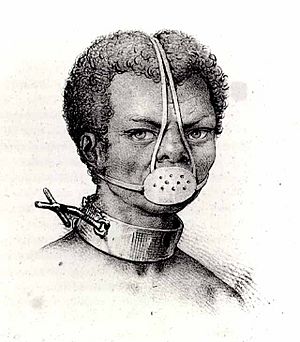Slave iron bit facts for kids
The iron bit was a cruel device used by enslavers in the Southern United States. It was a form of punishment for enslaved people. Sometimes it was called a gag.
This device worked a bit like a horse bit, which is used to control horses. Some people compare it to a scold's bridle. However, scold's bridles were mostly used on women in the 1600s. There are not many stories of them being called "scold's bridles" when used on enslaved Black people.
Unlike the whip, the iron bit is not as well-known in history or literature. But old stories from enslaved people and newspapers from the 1700s and 1800s show that this device was used to punish them.
What Was the Iron Bit?
A website about the history of slavery in the US shares a description from Thomas Branagan. He was a slave trader who later became an abolitionist, someone who worked to end slavery.
Branagan described the iron bit in his essay. He said it had "a flat iron which goes into the mouth." This part would hold down the tongue. It made it impossible to swallow anything, even saliva. There were small holes in the mouth-plate for saliva to pass through.
He also mentioned a "necklace" part. Hooks on it were meant to stop people from escaping in the woods. They also kept people from lowering their heads to rest.
Evidence from History
Many old articles and newspapers talk about devices that seem to be the iron bit. The name for the device could change depending on where it was used. People called it a mask, a bit, or a gag. These devices might have looked a bit different or been used for different kinds of punishment.
An article from 1848 in The North Star newspaper mentioned these devices. It said that places where enslaved people were sold had "iron thumb-screws and gags." They also had whips.
A man wrote a letter to the editor of the Frederick Douglass Paper. He described an abolitionist showing how enslavers treated people. The abolitionist put an "iron machine" on his head. This machine caused great pain. An "iron gag" went into his mouth. It held his tongue and stopped him from speaking. The abolitionist also showed whips and other tools used by enslavers.
An old newspaper ad from 1792 offered a reward for finding a runaway enslaved woman. The ad described her as "5 feet three or 4 inches high." It said she wore clothes common for enslaved people in summer. She also carried a white linen coat and jacket. The ad stated that she had been punished with an "iron collar."
Another article talked about how Delphine LaLaurie treated enslaved people in Louisiana. It said that seven enslaved people were found at her home. They needed medical help. Some were chained in uncomfortable ways. Tools for punishment were also found. These included "iron collars with spikes or sharp edges."
The Iron Bit in Books
Olaudah Equiano wrote about the iron bit in his own story. His book is called The Interesting Narrative of the Life of Olaudah Equiano. He called it the "iron muzzle." He wrote that "the iron muzzle, thumb screws, etc. are so well known as not to need a description." He added that they were sometimes used for even small mistakes.
Toni Morrison also mentioned this punishment in her famous novel Beloved.
See also
- Scold's bridle


